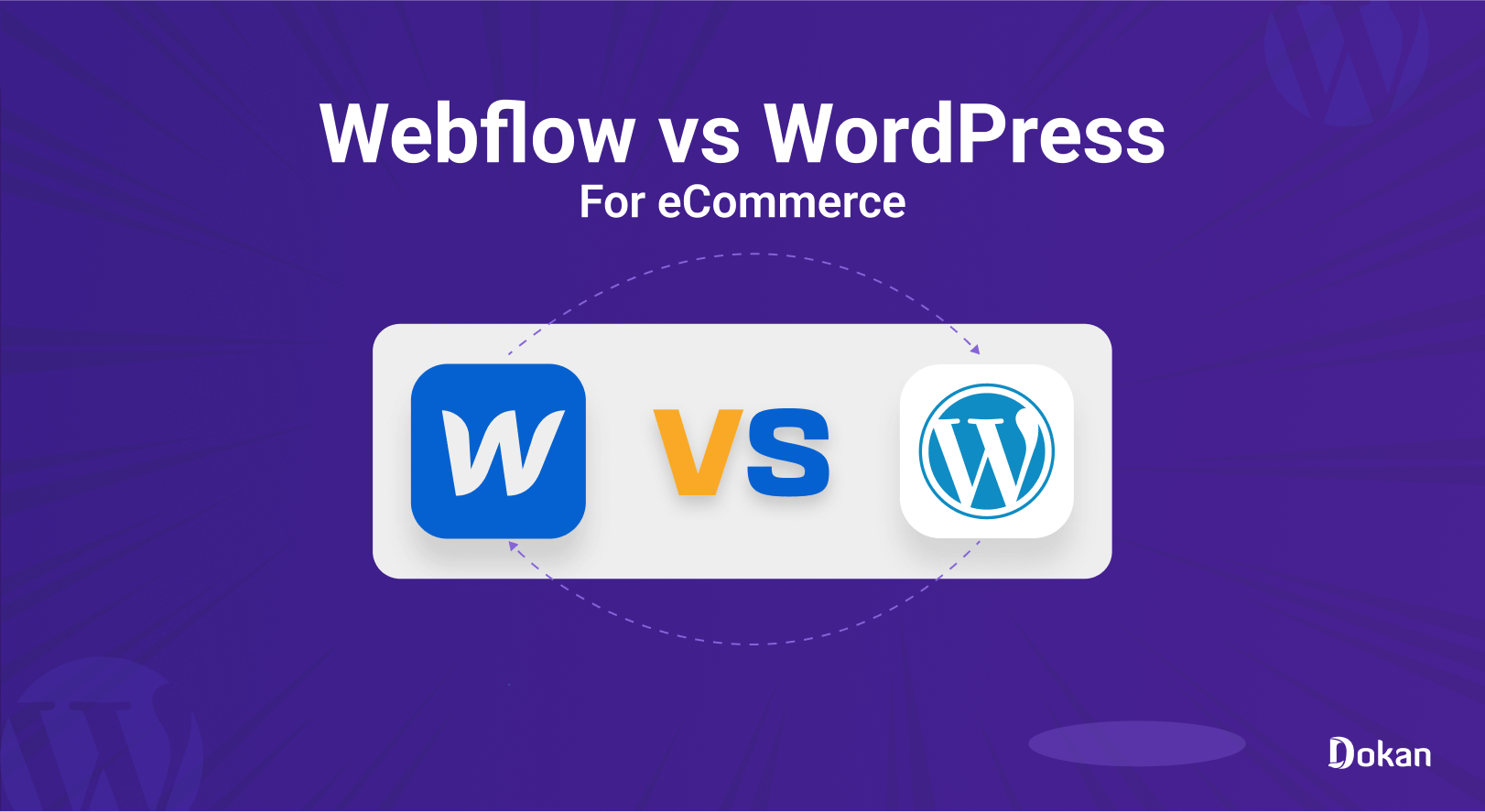When we are talking about the best eCommerce solution, two titans stand tall- Webflow and WordPress. Both platforms come with a number of features and capabilities to create any type of eCommerce store with ease.
Webflow was created by Vlad Magdalin with his brother Sergie, and their friend Bryant Chou in 2012. It’s a visual, no-code platform that empowers users to create stunning and pixel-perfect eCommerce websites without writing a single line of code.
On the other hand, WordPress is a giant in the CMS world, renowned for its flexibility and extensibility. It was founded by Matt Mullenweg in 2003. With its vast library of plugins and themes, WordPress can be molded into virtually any type of website, including eCommerce stores.
So, which platform is the right choice for your eCommerce venture? To help you make an informed decision, today, we are going to compare these two titans head to head. Keep reading!
Webflow vs WordPress– A Short Overview
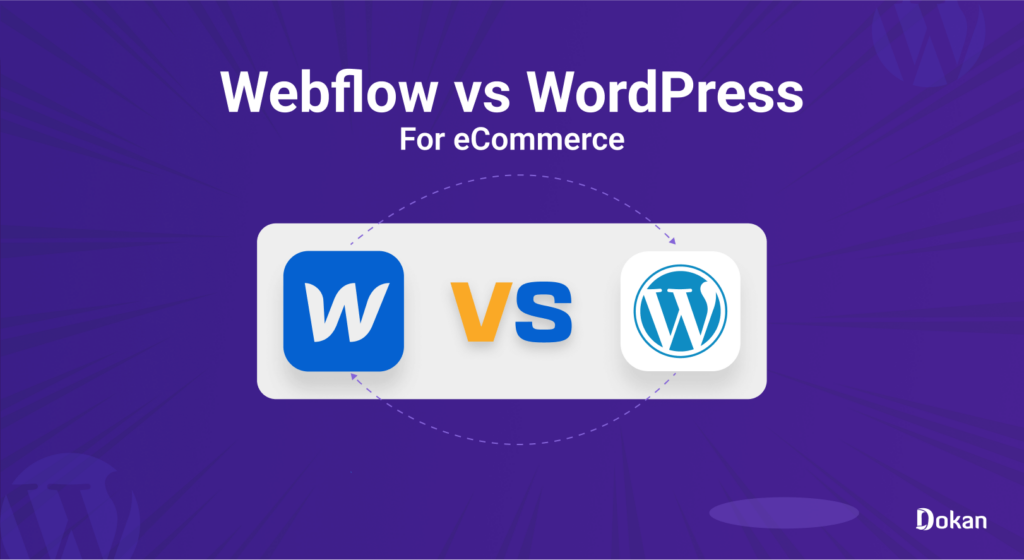
What is Webflow
Webflow is a popular hosted platform that allows users to design, build, and launch responsive websites without writing code. Since it’s a hosted platform, so you don’t need to buy domain and hosting from other providers. Webflow comes with domain and hosting included but you have to pay for it.
Its drag-and-drop interface makes it easy to add and customize elements on your page, and its built-in CSS editor gives you full control over the look and feel of your site.
Market Share of Webflow
According to W3Techs, Webflow has a market share of 0.7% of all websites and 3.33% of all websites that use a content management system (CMS).
This means that Webflow is used to power over 114,000 websites worldwide.
Webflow’s market share is still relatively small compared to other popular CMS platforms like WordPress and Joomla, but it is growing rapidly.
What is WordPress
WordPress is the most popular free and open-source Content Management System (CMS). It was launched back in 2003 as a blogging platform, but with time, it has become the most popular choice for creating any type of website that includes eCommerce websites as well.
The ease of use, user friendly interface, and little to no learning curve make this platform massively popular, especially among non-techy people.
Market Share of WordPress
As we already said, WordPress is the most popular Content Management System. According to the latest data shared by W3Techs, WordPress has a market share of 43.1% of all websites, as of October 12, 2023.
This means that WordPress powers over one-third of all websites on the internet.
If we look at only websites that are created with CMSs, WordPress’ market share is even higher: 63.1% of websites built with an identifiable content management system are currently using WordPress!
Webflow vs WordPress for eCommerce: Key Features, Similarities, and Differences

As we have said earlier, Webflow and WordPress both are Content Management Systems but they have some differences like WordPress is a self-hosted platform, on the other hand, Webflow is a hosted platform. That proofs both have some similarities and differences, right?
In this segment, we are going to briefly discuss the features, similarities, and differences between these two platforms.
Before that, let’s check the list of topics that we’re going to compare:
- Interface and Ease of Use
- Design and Personalization
- Shipping
- Tax
- Payment Gateways
- Security and Backup
- Product Management
- Marketing and SEO
- Help and Support
- Pricing
Now it’s time to dive into the details!
1. Interface and Ease of Use
As a beginner, first, you need to know which platform is the easiest to use. If your chosen platform has a complicated learning curve, it will demotivate you to continue further.
That is why, now we are focusing on which platform is easier to use between Webflow and WordPress.
Interface and Ease of Use of Webflow
Webflow is a user-friendly platform, especially for beginners. Its drag-and-drop interface makes it easy to add and move elements on your page, and its built-in CSS editor gives you full control over the look and feel of your site.
However, it is important to note that Webflow is a powerful platform, and there is a bit of a learning curve involved. If you are new to web design, you will need to spend some time learning how to use Webflow’s features to their full potential.
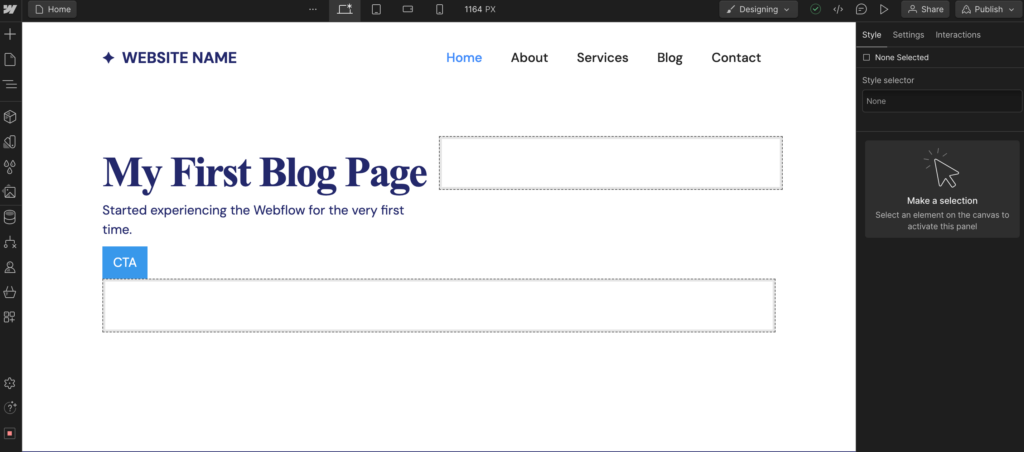
To get started with Webflow for creating your eCommerce website, first, you need to opt-in for a package. Then you will get some pre-built features of eCommerce like product management, shipping, taxes, order management, checkout, payment processing, etc., included in the package.
That means you’ll get everything in a package for creating any type of eCommerce website for you.
Interface and Ease of Use of WordPress
Unlike Webflow, WordPress is a self-hosted platform. That means you have to buy domain and hosting on your own from other providers. After buying a domain and hosting, you can easily install WordPress on your cPanel in 10 minutes. You’ll get a clean slate after installing the WordPress.
WordPress comes with a very easy user interface. Even if you have no prior experience with web development, you should be able to figure out how to use WordPress quickly and easily.
If you want to create any post, page, or media, you’ll get everything on the left sidebar.
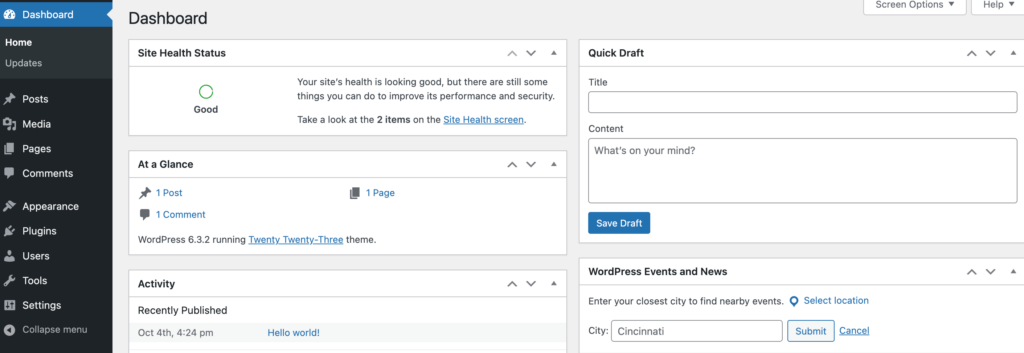
WordPress, by default, doesn’t come with any eCommerce features. So, to create an eCommerce store with WordPress, you have to install a free plugin called WooCommerce. This plugin has all the features to easily create and manage any kind of eCommerce store.
2. Design and Personalization
The competition among eCommerce site owners is fiercer now more than ever. Everyone wants to make their site stand out and so do you.
You can only make your site exceptional and attractive with a simple and sleek design. To do that you need to have design flexibility. In this part, we are going to discuss the design flexibility of these two platforms- Webflow and WordPress.
Webflow Design and Personalization
Webflow is popular for its design and personalization flexibility. Webflow comes with-
- Visual Editor: Webflow’s visual editor allows users to add and customize elements on their page using a drag-and-drop interface. This gives users full control over the layout and design of their website, without having to write any code.
- CSS Editor: Webflow also includes a built-in CSS editor, which gives users fine-grained control over the styling of their website. This allows users to create unique and eye-catching designs that are tailored to their specific needs.
- Custom Code: While Webflow is a no-code platform, it does allow users to add custom code if needed. This gives users even more flexibility to create the perfect website for their business.
- Pre-built Templates: Webflow also has a large and active community that has created and shared over 3000 custom templates and libraries. You’ll get both free and premium templates from this collection. Also, there are a number of templates that are specially built for eCommerce websites.
WordPress Design and Personalization
A) THEMES
- WordPress offers a vast library of themes, both free and premium, that control the overall look and layout of your site.
- In the WordPress repository, you will find 2200+ free themes for eCommerce stores.
- You can easily switch between themes, and most come with customization options for colors, fonts, and layout, allowing you to align your site’s appearance with your brand.

B) PLUGINS
- WordPress has more than 60,000 free plugins in the repository. And this number is only getting larger every day. Also, WordPress has a numerous number of third-party premium plugins available for you.
- For implementing eCommerce features like store SEO, payment gateway, shipping, product preview, etc., you will get several plugins for each purpose in the repository.
C) PAGE BUILDERS
- Page builder plugins like Elementor, Divi, and Beaver Builder empower you to create custom layouts with a user-friendly, drag-and-drop interface.
- These tools often include pre-designed content modules that simplify the process of adding various elements to your pages.
D) CUSTOM CSS
- If you have coding knowledge, you can add custom CSS styles to fine-tune your site’s design and appearance.
E) WIDGETS
- WordPress offers a range of widgets that you can place in widget-ready areas on your site. These widgets can display content like recent posts, categories, and more.
3. Shipping
Shipping is the process of delivering purchased products or goods from the seller’s location to the customer’s designated address. So, when you are selling products from your eCommerce store, it’s your responsibility to deliver products smoothly to your buyer’s address.
Let’s check which platform gives you the most flexibility in terms of shipping:
Shipping Feature of Webflow
Webflow’s shipping feature allows users to configure shipping rates and options for their customers. This can be done from the Webflow dashboard, and it is relatively easy to set up.
To use the shipping feature, users must first create a shipping zone. This is a geographical area that shipping rates and options will apply to. Once a shipping zone has been created, users can add shipping carriers and configure shipping rates.
Webflow allows users to create a variety of shipping rates, such as:
- Flat rate: This is a single shipping rate that applies to all orders, regardless of weight or distance.
- Free shipping: This option allows users to offer free shipping on all orders or on orders over a certain amount.
- Weight-based: This option calculates shipping rates based on the weight of the order.
- Distance-based: This option calculates shipping rates based on the distance between the shipping origin and the shipping destination.
Shipping Feature of WordPress
- eCommerce Plugin: To enable shipping features on your WordPress website, you’ll typically use eCommerce plugins such as WooCommerce, Easy Digital Downloads, or WP eCommerce. These plugins offer comprehensive shipping solutions.
- Shipping Method: eCommerce plugins provide a range of shipping methods to choose from, including standard shipping, express shipping, local pickup, and more. You can configure and customize these methods based on your specific business needs.

- Shipping Zone: You can define shipping zones, which are geographical regions where you offer shipping services. Each zone can have its own shipping methods, rates, and rules. This allows you to tailor shipping options to different locations.
- Shipping Calculators: eCommerce plugins often include shipping calculators that automatically determine shipping costs based on factors like package weight, destination, and shipping method. This provides real-time cost estimates during the checkout process.
- Shipping Rules and Discounts: You can set up rules and discounts related to shipping, such as offering free shipping for orders over a certain amount or applying discounts for loyal customers.
- Notifications and Tracking: You can set up automated notifications to keep customers informed about their order’s shipping status, including tracking information and estimated delivery dates.
4. Tax
Tax for an eCommerce website is the sales tax that you charge and collect from your customers. It is a percentage of the price of the items you sell, and it works similarly to the tax you would charge your customer in a physical store.
Let’s check how to handle taxes using Webflow and WordPress platform:
Tax Feature of Webflow
Webflow’s tax features allow users to automatically calculate sales tax for their customers in the United States, Canada, the European Union, and Australia. This is done using TaxJar’s comprehensive and constantly updated tax calculation system.
To use Webflow’s tax features, users must first enable tax calculation for their eCommerce store. This can be done from the eCommerce settings page. Once tax calculation has been enabled, users can configure the tax settings for their store.
Webflow’s tax settings allow users to specify the following:
- Tax Rates: Users can specify different tax rates for different products and services.
- Tax Exemptions: Users can exempt certain products and services from sales tax.
- Shipping origin: Users can specify the shipping origin for their orders. This is important because sales tax rates vary depending on the location of the shipping origin.
Tax Feature of WordPress
- WooCommerce Plugin: WooCommerce is a free, highly flexible eCommerce plugin for WordPress that provides robust features for managing taxes.
- Tax Configuration: Once WooCommerce is installed and activated, you can configure tax settings from the plugin’s settings in the WordPress dashboard. You can specify your business’s location and address to set up tax rates accordingly.
- Tax Zones and Classes: WooCommerce allows you to create tax zones, which are geographical regions where you’ll apply taxes. You can define different tax classes based on the type of products you sell, such as standard, reduced, or exempt.
- Tax Rates: Within each tax zone, you can set up different tax rates based on local tax laws or regulations. WooCommerce lets you create both standard and reduced tax rates as needed.
- Tax Calculation Options: You can choose to apply taxes based on the customer’s shipping address, billing address, or your store’s base location, ensuring accurate tax calculations during the checkout process.
5. Payment Gateways
A payment gateway is like a digital cashier for your eCommerce website. It securely collects and processes customer payments. It also offers features like fraud protection and works with various payment methods, making it easier for businesses to accept online payments.
Webflow and WordPress both have integration with popular payment gateways. In this part, we are going to discuss about that.
Webflow Payment Gateways
Webflow supports integration with a variety of payment gateways, including:
- Stripe
- PayPal
- Apple Pay
- Google Pay
- Amazon Pay
- Authorize.net
- Braintree
All of these payment gateways are integrated with Webflow, meaning that you can use them to process payments on your Webflow website without having to write any code.
Webflow does not currently support cash on delivery or direct bank transfer payments. However, there are third-party apps and integrations that can be used to add these payment methods to your Webflow website.
WordPress Payment Gateways
WooCommerce is the dedicated eCommerce solution for WordPress. It has integration with all the major payment gateways, including PayPal, Stripe, Wirecard, Google Pay, Apple Pay, etc. You can install the WooCommerce Payments plugin to accept credit cards, debit cards, and other popular payment methods.
You can also configure WooCommerce to accept the following payment methods:
- Check payments
- Cash on delivery
- Direct bank transfer
- Local payment methods, such as Boleto Bancário, Paytm, and Alipay
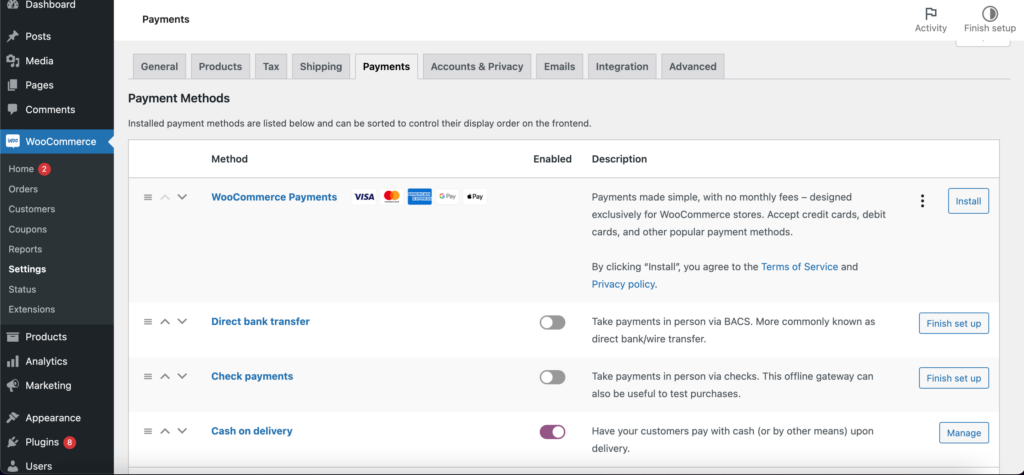
To configure WooCommerce to accept these payment methods, you will need to install and activate the appropriate extensions. For example, to accept check payments, you will need to install and activate the WooCommerce Checks extension.
6. Security and Backup
Security is one of the main concerns for an eCommerce website. Unless you are able to ensure bulletproof security for your site, you won’t be able to gain your customers’ trust.
Webflow and WordPress both are secure platforms. Also, they have different ways to provide automatic backup for your site. Let’s talk about that!
Webflow Security and Backup
Webflow takes security very seriously and implements a variety of measures to protect your website.
First of all, Webflow websites are hosted on Amazon Web Services (AWS), which is a leading cloud computing platform with a strong track record of security. Also, Webflow offers two-factor authentication (2FA) for all users, which adds an extra layer of security to your eCommerce store.
Like WordPress, Webflow allows you to assign roles and permissions to your users so that only authorized users have access to specific parts of your website.
In terms of Backup, Webflow automatically backs up all websites on a regular basis. These backups are stored in a secure location and can be restored at any time.
WordPress Security and Backup
WordPress has the largest number of users among all the CMS platforms. Since it has the most users, the possibility of attacks is higher here. WordPress itself is a secure platform, however, the problem arises when someone uses third-party plugins or themes from untrustable sources.
To tighten the security of your WordPress-powered eCommerce store, you have to use a security plugin like Wordfence, Sucuri, Security Ninja, etc.
Since WordPress doesn’t offer any built-in backup service, you have to install a backup plugin like UpdraftPlus, BlogVault, Duplicator, etc. to ensure automatic backup for your eCommerce site.
You should also regularly update your WordPress core version, plugins, and themes to secure your website from any unwanted threats.
Subscribe to
Dokan blog
7. Product Management
Product management for an eCommerce website involves handling everything related to the products you sell online. This includes creating detailed product listings with descriptions and images, organizing products into categories, setting prices, managing stock, optimizing for search engines, and presenting products attractively.
Let’s check how Webflow and WordPress manage products:
Webflow Product Management
- Product Listings: Webflow allows you to create detailed product listings with descriptions, images, and other relevant information. You can also organize products into categories and subcategories, and set up product variants and options.
- Product Search: Webflow has built-in product search functionality, so customers can easily find the products they’re looking for.
- Product Recommendations: Webflow allows you to recommend related products to customers based on their browsing and purchase history.
- Product Reviews: Webflow allows customers to leave reviews and ratings on products, which can help other customers make informed purchase decisions.
- Inventory Management: Webflow allows you to track inventory levels and set up notifications when stock is low.
WordPress Product Management
- Product Creation: WooCommerce- an eCommerce solution for WordPress, makes it super easy to add, edit, and delete any products to your eCommerce store. It enables you to create detailed product listings, including product descriptions, images, pricing, and variations.
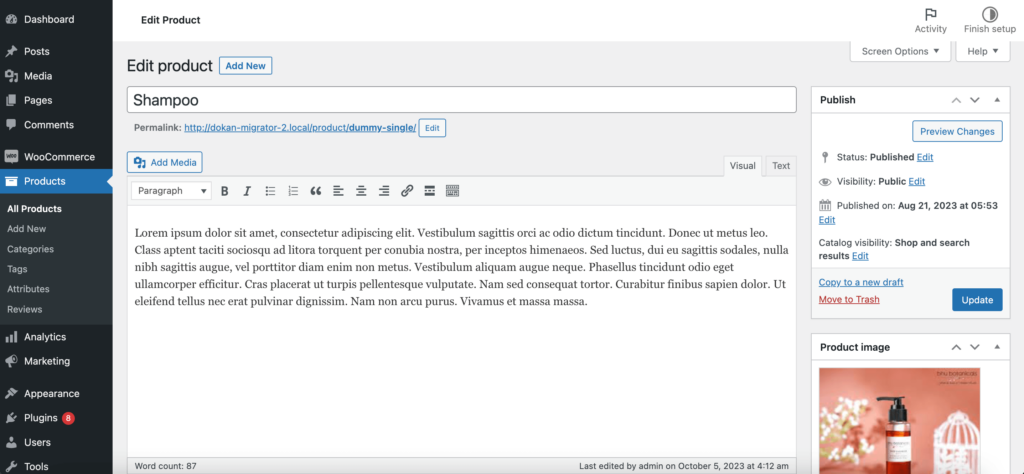
- Customization: You can customize products with various attributes, including size, color, SKU, and more. This flexibility allows you to cater to different product types and variations.
- Categories and Tags: Organize your products by categorizing them and adding tags for easy navigation. This enhances the user experience, helping customers find products quickly.
- Inventory Management: Keep track of your product stock levels, receive low-stock notifications, and manage inventory efficiently. Various inventory management features are available through WooCommerce and other eCommerce plugins.
- Product Images and Galleries: WordPress provides excellent support for product images and galleries. You can showcase your products with high-quality images and create appealing product displays for your online store.
8. Marketing and SEO
Marketing for an eCommerce site involves strategies to attract customers, such as creating content, using social media, and email marketing.
As an eCommerce store owner, it’s your utmost priority to attract customers to your store. Here is how Webflow and WordPress will help you to get this job done.
Marketing and SEO of Webflow
- Customizable Meta Description and Titles: Webflow allows users to customize the meta descriptions and titles for each page on their website. This is important for SEO, as it helps search engines understand what each page is about.
- Alt Text for Images: Webflow allows users to add alt text to their images. Alt text is a brief description of an image that is displayed to users who cannot see the image. This is important for both accessibility and SEO.
- Social Media Integration: Webflow allows users to integrate their website with social media platforms such as Facebook, Twitter, and LinkedIn. This makes it easy for users to share content from their website on social media.
- Email Marketing Integrations: Webflow integrates with a number of email marketing platforms such as MailChimp and Constant Contact. This makes it easy for you to collect email addresses from your visitors and send them email newsletters.
Marketing and SEO of WordPress
- Built-in Features: WordPress doesn’t offer any built-in features for marketing and SEO except permalink settings. But there are several free plugins to get this job done.
- SEO Optimization: WordPress offers powerful SEO capabilities. You can customize meta tags, URLs, and other SEO elements, enhancing your website’s visibility in search engine results. Popular SEO plugins like Yoast SEO and All in One SEO Pack provide these features.
- Blogging: WordPress is renowned for its blogging feature. You can easily create and organize content, including articles, blog posts, landing pages, and more, allowing you to effectively engage your audience and improve SEO.
- Social Media Integration: WordPress seamlessly integrates with social media platforms. You can share content, add social sharing buttons, and engage with your audience on various social networks, extending your reach and increasing brand visibility.
- Email Marketing: WordPress supports email marketing through plugins like Mailchimp, Constant Contact, etc. These tools allow you to build email lists, send newsletters, and run targeted email campaigns to promote products or services effectively.
- SEO Plugins: WordPress has a vast collection of SEO plugins. In addition to Yoast SEO and All in One SEO Pack, you can explore plugins like Rank Math and SEOPress, which offer advanced SEO features and enhancements.
9. Help and Support
Help and support for an eCommerce site are essential features to ensure a smooth and successful online shopping experience for both customers and store owners.
Let’s check what Webflow and WordPress offer to make sure better help and support for your store:
Help and Support of Webflow
Webflow offers a variety of help and support resources to its users, including:
- Help Center: The Webflow Help Center is a comprehensive resource that contains articles, tutorials, and videos on all aspects of using Webflow. The Help Center is searchable, so you can easily find the information you need.
- Community Forum: The Webflow Community Forum is a place where users can ask questions and get help from other Webflow users. The forum is moderated by Webflow staff, so you can be sure that you are getting accurate information.
- Email Support: Webflow offers email support to all of its users. You can submit a support ticket and a Webflow team member will respond to you as soon as possible
- University Courses: Webflow offers a variety of online courses that can help you learn how to use Webflow. These courses are taught by Webflow experts and cover a wide range of topics.
Help and Support of WordPress
WordPress doesn’t provide any direct support like email ticketing, or WhatsApp messaging. But you can get answers to your every query through its community, official documents, and forums. Since it has the largest user base, so you won’t feel alone whenever you need any help.
- Official WordPress.org Support Forums: WordPress.org hosts an active support forum where users can ask questions, seek help, and share their experiences. The forum is a valuable resource for free users, and you can usually find solutions to common issues and answers to your questions.
- Official WordPress Documentation: The WordPress Codex and official documentation provide a wealth of information. They cover a wide range of topics related to WordPress usage, configuration, themes, plugins, and more.
- WordPress Community: WordPress has a vibrant and helpful community of users and developers. You can connect with other WordPress enthusiasts on various social media platforms and join user groups for support, advice, and discussions.
- Plugin and Theme Support: If you encounter issues with specific plugins or themes, you can often seek support through the official WordPress Plugin and Theme directories. Many developers provide support forums for their products, even for free versions.
- WordPress Meetups: WordPress Meetup groups often organize local and virtual events where users can meet, share experiences, and seek help. Check for meetups in your area or attend virtual meetups to connect with other users.
10. Pricing
You may have a limited budget for your eCommerce store. By checking the pricing of these platforms, you can find a platform that fits your budget and allows you to create a successful eCommerce store without breaking the bank.
Webflow Pricing
Webflow offers a variety of pricing plans to meet the needs of different users. The plans are as follows:
- Starter: The Starter plan is free to use and allows users to create up to two websites with 50 CMS items per website.
- Basic: The Basic plan costs $14 per month when billed annually ($18 per month when billed monthly) and allows users to create up to 10 websites with 1,000 CMS items per website.
- CMS: The CMS plan costs $23 per month when billed annually ($29 per month when billed monthly) and allows users to create unlimited websites with unlimited CMS items.
- Business: The Business plan costs $39 per month when billed annually ($49 per month when billed monthly) and includes all of the features of the CMS plan.
- Enterprise: The Enterprise plan is a custom plan that is designed for businesses with high-volume needs.
WordPress Pricing
WordPress is an open-source and free content management system. So, you don’t have to pay any fee to use this platform to create your eCommerce websites.
Cost of Creating an eCommerce Site Using Webflow and WordPress
| Webflow | WordPress | |
|---|---|---|
| Platform Fee | Between $14 to $39 per month | Free |
| Domain | Included in the package | Between $5 to $10 per year |
| Hosting | Included in the package | Between $200 to $250 per year |
| Development and Customization | Between $1500 to $3000 | Between $1500 to $5000 |
| eCommerce extensions | Between $0 to $500 | Between $0 to $500 |

Comparison Table of Webflow vs WordPress for eCommerce
Here’s a table comparing Webflow and WordPress based on some key points:
| Webflow | WordPress | |
|---|---|---|
| Ease of Use | User-friendly visual editor for design | User-friendly, but may require plugins for advanced features |
| Cost | Subscription-based pricing (between $14 to $39 per month) | Open source, with hosting and domain costs |
| eCommerce Features | Built-in, suitable for small to medium stores | Requires plugins, well-supported for online stores |
| SEO | SEO-friendly with plugins, needs configuration | SEO-friendly with plugins, need configuration |
| Security | Secure hosting, SSL, and DDoS protection | Secure but may require additional security plugins |
| Support | Paid support plans, active community | Community support, paid support available |
| Blogging | Suitable for basic blogs | Excellent for blogging with plugins |
| Multilingual | Supports multilingual sites | Supports multilingual sites with plugins |
| Developer Tools | Suitable for designers and no-coders | Offers development flexibility with coding |
| Good For | Design-focused websites, small to medium businesses | Versatile, suitable for a wide range of sites |
| Limitations | Limited coding access for advanced users | Learning curve for beginners, plugin reliability |
| Multivendor Support | Supports with custom development | Supports with plugins and extensions |
Which Platform Is Better for eCommerce- Webflow vs WordPress?
Webflow is a hosted platform, on the other hand, WordPress is a self-hosted platform. Both make the process easier for you to create your eCommerce store without being a code-expert.
Let’s find out which platform is better for what reasons!
Reasons to Choose Webflow Over WordPress:
- Design flexibility
- Built-in eCommerce features
- All in one (domain+hosting+eCommerce features) solution
- Security
- Support
Reasons to Choose WordPress Over Webflow
- Ease of use
- Extensive plugins and themes ecosystem
- Content and marketing
- SEO-friendly
- Lower cost
- Community
- Product management
That’s all!
We hope, now you know which platform would be the best solution for you to create your eCommerce website. You can share your thoughts with us using the comment box below. Thank you!
Check our other popular comparison posts on WordPress vs different eCommerce platforms-
Subscribe to
Dokan blog
We send weekly newsletters, no spam for sure!
